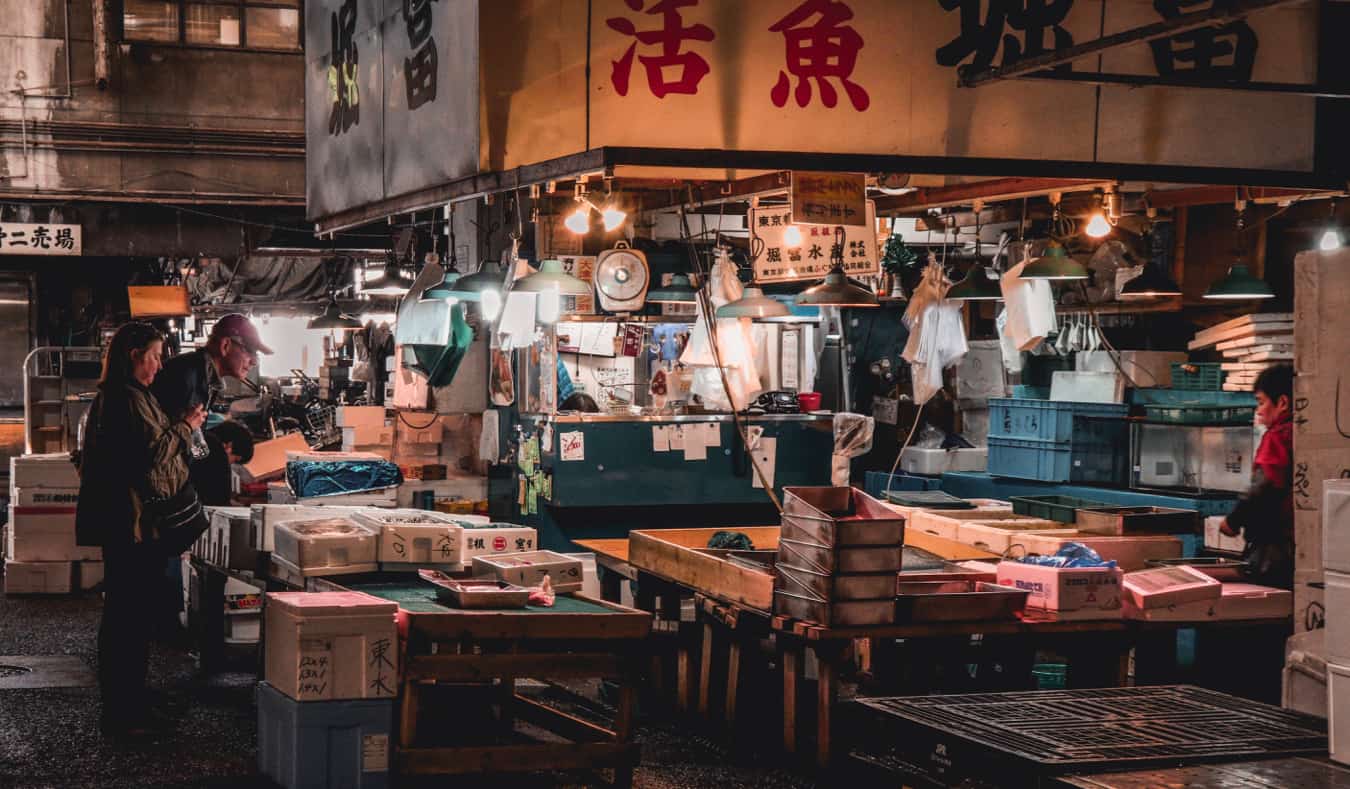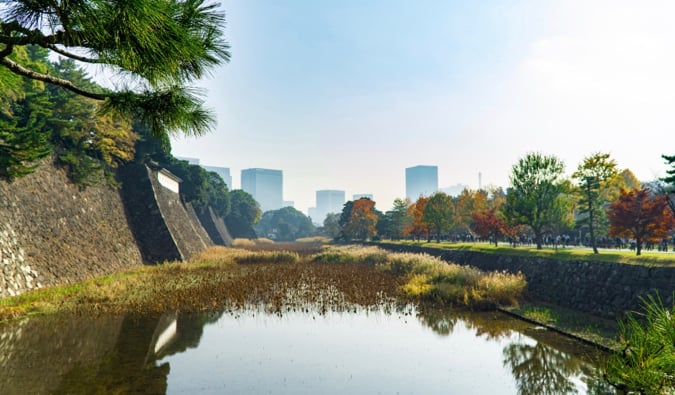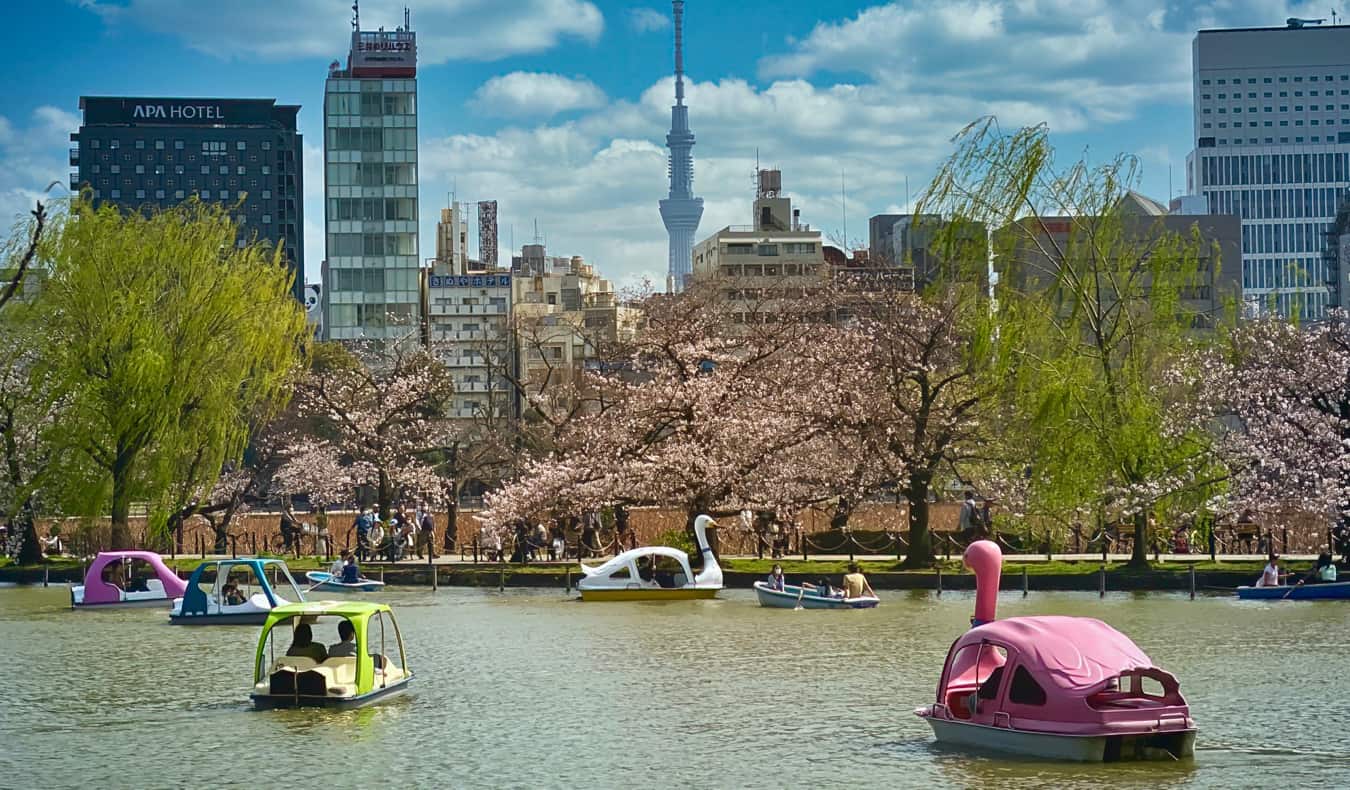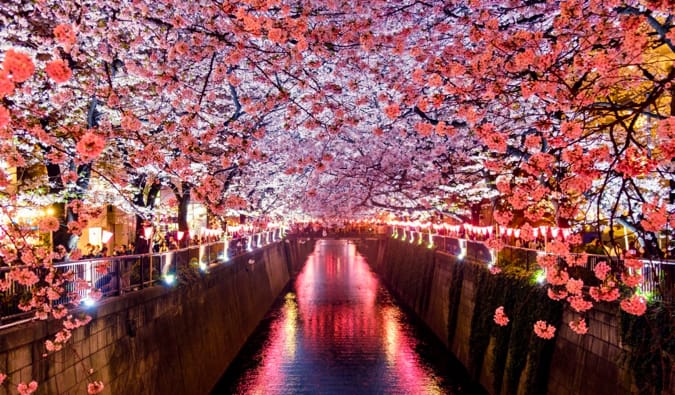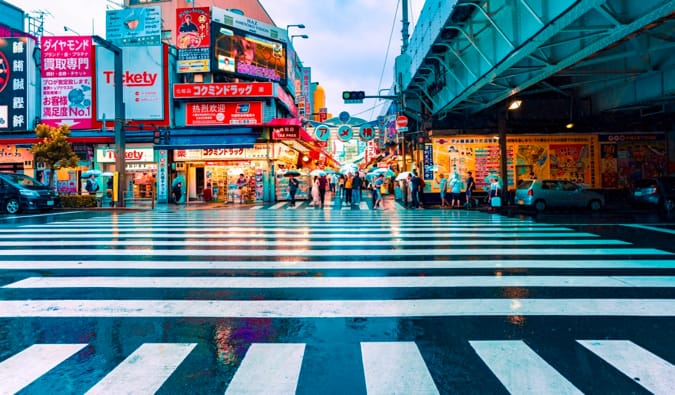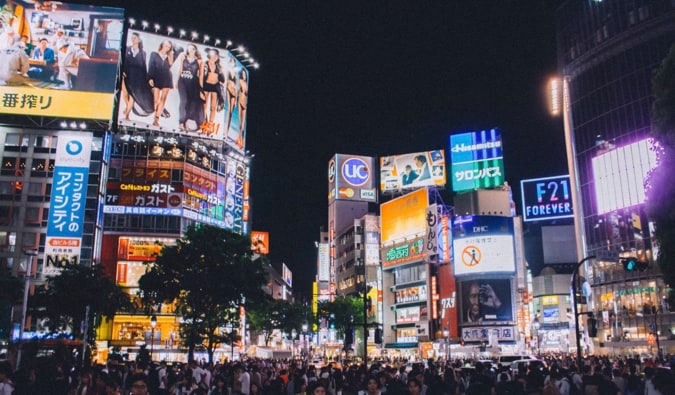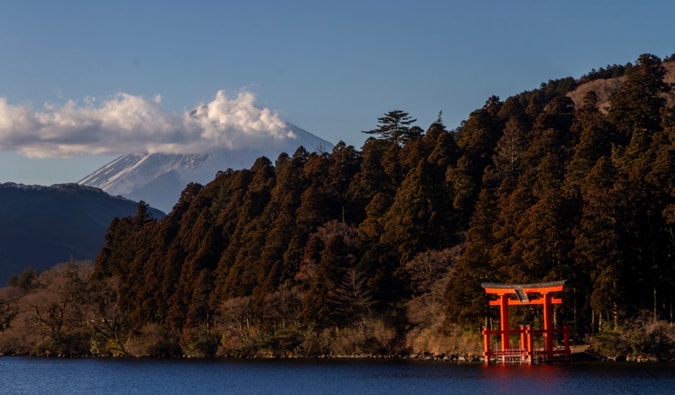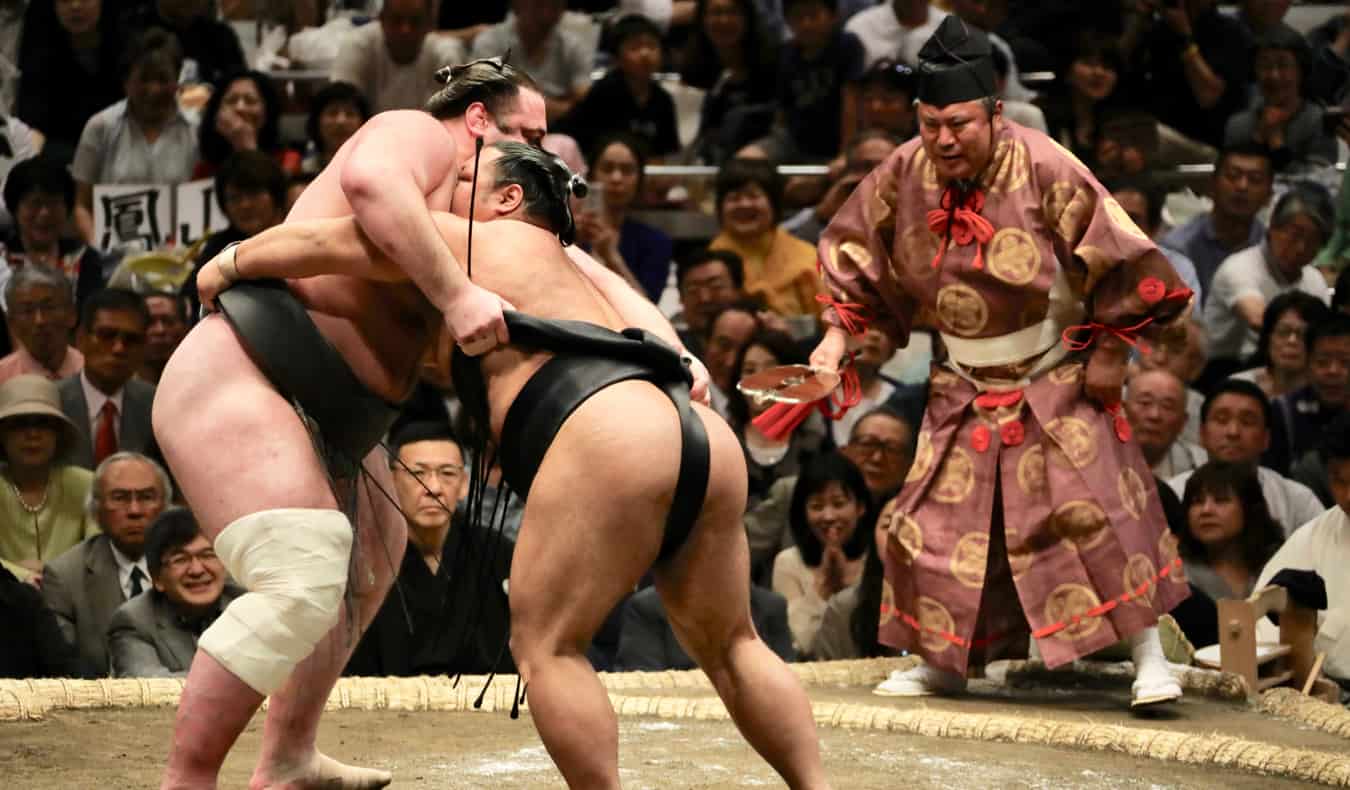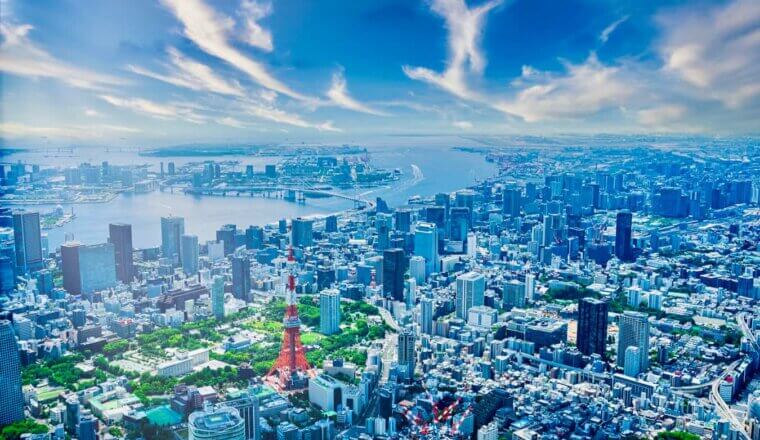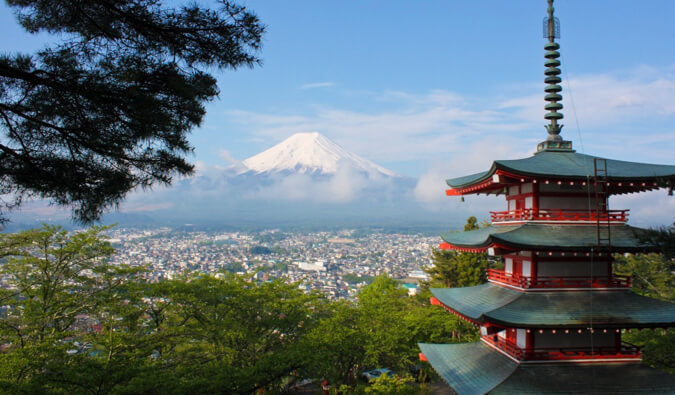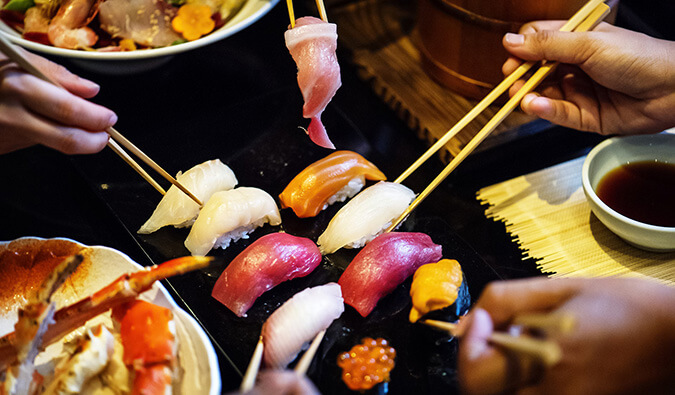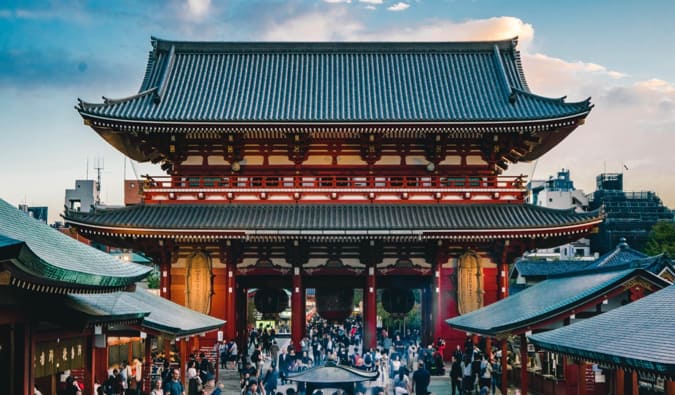
Last Updated: 8/6/2023 | August 6th, 2023
Tokyo is an incredible, massive city home to over 13 million people. It’s the capital of Japan and home to a wide array of fun, historic, and quirky attractions. From the world’s largest tuna auction and the Imperial Palace to ninja restaurants and vampire cafés, Tokyo really does have something for everyone.
Whether you’re here for a short stopover or living here as an expat, you’ll be able to find plenty of ways to pass the time and get a feel for the organized chaos that is Tokyo. To help you make the most out of your trip, here are the best things to see and do in Tokyo:
1. Visit the Fish Market
The Tsukiji Fish Market was one of the most iconic staples of the city. In 2018, the market moved to Toyosu and is now twice the size of the original Tsukiji market. In fact, the new market is the largest fish market in the entire world. While you’ll need a visitor’s pass to enter (you can get one on arrival), the pass is free (which means you’ll have more money to spend on sushi!)
There are over 600 vendors here selling fresh fish as well as fresh fruits and vegetables. Gorge on sushi and marvel at the chaotic atmosphere of the world’s largest tuna market. The tuna auction here powers much of the world’s sushi supply, and it is truly a sight to be seen. You can also see a model of the largest tuna ever sold at Tsukiji — which weighed 500kg (1,100lbs!).
In addition to the new market, the old outer market at Tsukiji still has plenty of restaurants and shops. You can still head there to eat and look around, though all the action is now at Toyosu. Be sure to arrive early to beat the crowds (especially on Saturdays). Food and drink tours of the Tsukiji Outer Market are available for around 13,500 JPY.
Tsukiji Fish Market: 5 Chome-2-1 Tsukiji, Chuo, +81 3-3542-1111. Admission is free. Toyosu Fish Market: 6 Chome-6-2 Toyosu, Koto, +81 3-3520-8205. Open Monday-Saturday from 5am-5pm, though most shops don’t open until 7am. Most shops are closed on Sundays and holidays. Admission is free.
2. Explore by the Imperial Palace
The Imperial Palace is the official home of the Emperor of Japan. It’s a terrific spot to learn about Japan’s history and culture. Formerly Edo Castle, the palace was built in the 15th century, and some of the walls and moats from that time are still in use to this day. When the Emperor moved from Kyoto to Tokyo in 1869, he took Edo for his new palace and renamed it the Imperial Palace.
You can’t go inside (or even get super close), however, the building itself is both regal and serene and a great place to relax or snap some photos. The palace is surrounded by beautiful grounds and a park, and there’s a moat around the massive stone walls. Admission to the grounds is free.
3. Experience a Tea Ceremony
No visit to Japan is complete without experiencing a traditional tea ceremony. Tea was brought to Japan in the 9th century by a Buddhist monk and by the 12th century, the ceremony began to take shape. While these ceremonies are usually long (not to mention expensive), they are worth splashing out on if you want a deep dive into traditional Japanese culture. The experience involves learning about tea, preparing matcha (a powdered green tea), and then drinking the tea, often with a sweet. Budget experiences start at around 6,000 JPY per person.
4. Relax in Ueno Park
Ueno Park is a relaxing and beautiful spot to relax for a few hours (or an entire day if you’re not in a rush). It’s a serene spot to photograph the many cherry trees that line the park (which blossom in April and are a huge tourist draw) or to have a picnic on a sunny summer afternoon.
There are also a few important things to see in the park as well. Here are a few sights in the park you should make time to visit:
- Tokyo National Museum – Established in 1872, this museum is located in the north end of the park and houses one of the world’s largest collections of art and artifacts from Asia, particularly Japan. 13-9 Uenokoen, Taito, +81 3-3822-1111, tnm.jp. Open daily 9:30am-5pm (8pm on most Fridays). Admission is 1,000 JPY.
- Tosho-gu Shrine – This is a 17th-century Shinto shrine with stunning gold doors and ornate carvings. Admission is 1,300 JPY to the shrine and an additional 1,000 JPY for the museum. 9-88 Uenokoen, Taito, +81 3-3822-3455, uenotoshogu.com/en. Open daily 8am-5pm.
- National Museum of Western Art – Opened in 1959, this is one of the only art galleries in the country to focus on Western art. The collection is comprised of 5,000 pieces, dating from the Renaissance all the way to the 20th century. There are works by Van Gogh, Monet, Renoir, and Picasso as well as sculptures dating back to the 14th century.7-7 Uenokoen, +81 3-3828-5131 , nmwa.go.jp. Open Tuesday-Sunday 9:30am-5:30pm (8pm on Fridays and Saturdays). Admission is 500 JPY.
5. See the Tokyo Metropolitan Teien Art Museum
This small museum used to be the official residence of the Prince and Princess Asaka. Built in 1933, the building itself was influenced by the art deco movement in Paris. The prince had studied in Paris and wanted to bring the art deco style to Japan, hence the building’s style and decorations. In 1983, the residence transitioned into a museum and is now home to a rotating series of modern art exhibitions. See their website for information on what exhibits are available.
5-21-9 Shirokanedai, +81 3-3443-0201, teien-art-museum.ne.jp/en. Open daily 10am-6pm (closed Mondays.) Admission is 1,400 JPY, with discounts available for students, children, and seniors.
6. Stroll Along the Meguro River
The Meguro River weaves almost five miles through the city and makes for a magnificent stroll. There’s a path with a bit of green space that follows the water, so plenty of locals walk or exercise there. In the spring, you’ll be able to see a lot of cherry blossoms as you walk along the banks of the river as well.
While the walk is nice at any time of year, late March to early April is when the cherry blossoms will be in bloom. While there will be a lot of people then (cherry blossom viewing is a national pastime) you’ll be rewarded with some beautiful scenery in the heart of the metropolis.
7. Check out Asakusa
If you want to check out some of Tokyo’s historic and culturally-significant religious sites, be sure to spend some time wandering around Asakusa. Two places that I’d suggest you visit are:
- Senso-ji – This is Tokyo’s most popular (and arguably most famous) temple. It’s beautifully painted and sits in a scenic spot near a pagoda and the Kaminari Gate. There’s a huge statue of Kannon, the goddess of mercy, inside the main hall. It’s busy during the day so aim to visit in the evening to beat the crowds. 2 Chome-3-1 Asakusa, Taito, +81 3-3842-0181, senso-ji.jp. The grounds are open 24/7, though the temple itself is open daily 6am-5pm. Admission is free.
- Asakusa Shrine – This is a Shinto shrine located near Senso-ji. It’s much more peaceful and less busy than Senso-ji as well. It was built during the Edo period and miraculously survived the air raids of World War II. 2 Chome-3-1 Asakusa, Taito, +81 3-3844-1575, asakusajinja.jp. Open 24 hours. Admission is free.
8. Have Dinner with Ninjas
For a unique dining experience, head to Ninja Akasaka. It’s a novelty ninja-themed restaurant designed like an Edo-era building. The waitstaff is clothed in stereotypical all-black garb and trained in all sorts of simple tricks, sleight of hand, and illusions. You’ll order off of old scrolls while being entertained by the skillful tricks of your server. The food isn’t anything special but it’s super fun (especially if you’re traveling with kids) and the atmosphere is unique.
Tokyu Plaza Akasaka, +81 3-5157-3936, ninjaakasaka.com. Open daily 5pm-10:00pm (and from 11:30am-2:30pm on Saturdays and Sundays)
9. Drink in Golden Gai
If you are looking for something interesting to do at night, this alley of backstreet bars should not be missed. There isn’t much going on here during the day, but come sundown, these zigzag hallways and closet-sized beer rooms are filled with interesting people and cheap drinks. There are six alleys connected by narrow passageways only wide enough for 1 or 2 people, making it a rather unique place to start your night out on the town. While many bars are open to everyone (including tourists), some only serve their regulars. Golden Gai is located in Shinjuku.
10. Visit the National Art Center
Opened in 2007, this museum and gallery doesn’t actually have a permanent collection but rather houses a never-ending series of temporary exhibitions, from impressionism to modern art (the Monet exhibition that was held here in 2007 was the most visited exhibition in the world). There are upwards of 60 exhibitions each year so check their website to see what is currently being shown.
7 Chome-22-2 Roppongi, +81 3-5777-8600, nact.jp. Open Wednesday-Monday 10am-6pm. Admission varies by exhibit.
11. Eat Below the Girders
Not far from Ginza is the Yurakucho neighborhood. Below the elevated train tracks at Yurakucho Station is a 700-meter-long (2,296 feet) stretch of restaurants and bars. There are wine bars, beer pubs, and casual restaurants filled with businessmen. If you want to get a sense of local city life, this is a good neighborhood to explore after the workday is over.
12. Go Superhero Go-Karting
If you’re a video game fan (or just want to do something different), check out Street Kart. This is a real-life Mario Bros. go-kart company that lets you dress up and race around the city. As long as you have an international driving permit (which you can get if you have a valid driver’s license), you can take part, racing around the city dressed up as Mario, Yoshi, or even Spiderman. There are both private and group tours, with multiple departure locations that cruise through different neighborhoods.
4-12-9 Sotokanda, +81 80-8899-8899, maricar.com/en/akihabara.html. Open daily 10am-10pm. Expect to spend about 1-2 hours and 10,000-18,000 JPY per person depending on the options you choose. An International Driving Permit is required to participate, which you can procure with a current valid driver’s license before you leave home.
13. Check out a Sento
A sento is a traditional (and communal) Japanese public bathhouse. In the past, private baths were rare as accommodations in Japan are notoriously small. While private baths are much more common today, sentos remain important cultural hubs. The Japanese are not shy in sentos so you need to be comfortable with nudity! They are typically separated by gender. A budget-friendly sento will cost you just under 1,000 JPY. Just keep in mind that many have rules against tattoos.
14. Visit a Quirky Café
Tokyo has all sorts of weird and wonderful cafés. Monster cafés, cat cafés, dog cafés, owl cafés, vampire cafés, and much more! If you can think of it, there is probably a café for it somewhere in the city. If you’re looking for something unusual to do (or just want a place to relax after exploring) then take a look and see what weird and quirky cafés are near you (they’re all around the city so you never have to go far to find one!).
Here are some suggestions to help you get started:
- Kawaii Monster Café (monster themed)
- Vampire Café (vampire/goth themed)
- Dog Heart (dog café)
15. See Shibuya Crossing
This is generally considered to be the busiest (and most famous) intersection in the world. This nearby metro station transports 2.4 million people per day and it’s estimated that upwards of 2,500 cross it at a time during rush hour. At night, the interaction is buzzing. Futuristic bright lights line the streets, with billboards playing videos and ads. It has a sci-fi feel to it (it kind of reminds me of Times Square on steroids).
While you’re here, make sure to visit the statue between Shibuya Station and the intersection. It’s a tribute to Hachiko, who would greet his owner at Shibuya Station every day until the owner passed away at work in 1925. Hachiko visited the train station daily and waited for his owner until he also passed away a decade later. He is a national hero in Japan and his story is well-known as it highlights the virtues of loyalty and devotion, which are highly valued in Japanese culture. The dog is something of a national icon in Japan, and the story was made famous by the film Hachi: A Dog’s Tale. You can find Hachiko, unsurprisingly, at the Hachiko Exit.
16. Stroll Around Shimokitazawa
Brimming with vintage shops, this Bohemian neighborhood is often compared to New York’s East Village. It’s a great example of the quieter side of Tokyo and offers some more relaxing streets to wander and window shop. Whether you’re looking to shop or just want to take in the scene, this is a cool neighborhood to explore for a couple of hours.
17. Gaze at Mt. Fuji from Hakone
If you want to take a day trip (or a multi-day trip) from the city, consider going to Hakone. It’s located just over an hour from Tokyo and is one of the best places to get away from the city, relax for a few days, and take in the view of Mount Fuji. There are numerous guesthouses in the area, many with their own private onsen (natural hot springs), making it a great place to go for a romantic getaway or if you just want to pamper yourself.
If you have the Japan Rail Pass you can get here for free.
18. Hang with the Harajuku Girls
Harajuku is an electric and quirky part of town known for its fashion, vintage stores, and cosplay shops. As you wander, you’ll often see “Harajuku girls” walking around town in unique clothing and colorful hairstyles. In addition to all of the avant-garde fashion, there are also tons of trendy restaurants in the area as well. It’s one of the best places to come and people watch and appreciate Japan’s more unique cultural trends.
19. Watch a Sumo Match
Kokugikan is Japan’s most famous sumo wrestling arena. It hosts tournaments three times each year, all of which draw huge crowds. Sumo wrestling (the kind we are familiar with today) dates back to the 17th century, though its origins date back even further. Even to this day, it’s still one of the most popular traditions in the country. If you’re in town at the right time, this is a must-do (even if you’re not a sports fan, it’s a unique and rare opportunity). Tickets sell out quickly so be sure to book early.
1 Chome-3-2-8 Yokoami, Sumida, +81 3-3623-5111, sumo.or.jp/kokugikan. Ticket prices vary, but expect to pay around 3,800 JPY.
20. Watch Traditional Japanese Theater
Kabuki theater is a traditional form of Japanese performance involving dance and drama. The costumes and makeup are heavily stylized, making for a very visual performance. The Kabuki-za Theatre, located in Ginza, is the best place to see these incredible and powerful performances. You can purchase tickets for an entire show or just one act if you’re not ready to commit to a longer performance (they’re in Japanese and usually last a few hours).
4 Chome-12-15 Ginza, +81 3-3545-6800, kabuki-za.co.jp. Performances are held almost daily. Check the website for the mosvv t up-to-date schedule. Expect to pay at least 3,500 JPY for a single-act ticket.
21. Visit Daibutsu (the Great Buddha)
For another day trip, head to Kamakura. Here you’ll find a 13-meter (42-foot) bronze statue of Buddha that was built in 1252. The statue was initially constructed within a temple, but the temple was washed away — on several occasions — by storms. Today, the statue now sits in the open air (along with a massive pair of straw sandals that belong to the statue). You can even go inside the statue itself (there isn’t much to see, but it’s still kind of neat to be able to step into a massive statue of that size and importance).
The journey to Kamakura takes around an hour and is free with a Japan Rail Pass.
4 Chome-2-28 Hase, Kamakura, +81 467-22-0703, kotoku-in.jp. Open daily 8am-5:30pm. Admission is 200 JPY.
22. Visit the Ghibli Museum
If you’re a fan of the award-winning director Hayao Miyazaki’s work (he’s the genius behind Spirited Away, Howl’s Moving Castle, and Princess Mononoke), then you’ll want to check out this amazing museum. The exhibition was actually designed by Miyazaki himself and is an immersive experience that any film buff will appreciate. The museum hosts a new short film every month, only available to visitors. While a visit here won’t take up a whole day, it’s not in a very central location so you’ll need to plan accordingly (it’s about an hour from downtown Tokyo).
1 Chome-1-83 Shimorenjaku, +81 570-055-777, ghibli-museum.jp. Open weekdays from 10am-5pm and weekends from 10am-7pm. Admission is 1,000 JPY for adults, with discounts available for youth and children. There are limited tickets available each day so book in advance.
23. Get Touristy at Tokyo Disneyland
I’m a sucker for Disney attractions! This is a fun choice for anyone traveling with children, but also for any adults who just love amusement parks. Opened in 1983, it has seven themed areas to explore and is the third most visited theme park in the world (almost 18 million people visited pre-COVID). It has a lot of the same famous rides you’ll find at Disney World such as Splash Mountain, The Haunted Mansion, and the nauseating Mad Tea Cup Ride. It’s best to book online in advance.
1-1 Maihama, Urayasu, +81 45-330-5211, tokyodisneyresort.jp/tdl. Open daily 8am-10pm. Admission is 9,400 JPY for adults and 5,600-7,800 JPY for children, depending on age.
24. Hike Mount Mitake
Located just over an hour from Tokyo is Chichibu-Tama-Kai National Park. The park covers 1,250 square kilometers (482 square miles) of rolling hills, mountains, and lush forests. There are plenty of hiking trails, though you can also take a cable car to the top and then hike to the shrine that sits on the peak, some 930 meters (3,051 feet) above sea level. It’s a 30-minute walk to the shrine from the peak/top of the cable car. From there, you can hike for an hour to a small valley with two picturesque waterfalls or continue on to Mount Otake, which is about two hours from the summit of Mount Mitake.
25. Stroll through Shinjuku Gyoen National Garden
This park spans over 144 acres and is home to some 20,000 trees. Most of the original park was destroyed in World War II, however, it was rebuilt and reopened in 1949. During spring, the park is one of the best spaces to see cherry blossoms. My favorite part is the Japanese landscape garden, which has several ponds with bridges and islands. It’s a peaceful little oasis within the hustle and bustle of the city.
11 Naitomachi, Shinjuku, +81 3-3350-0151, env.go.jp/garden/shinjukugyoen/index.html. Open Tuesday-Sunday 9am-4pm. Admission is 500 JPY.
26. Visit the Tokyo Tower
Built in 1957, with many other replica towers being erected country-wide, this bright Eiffel Tower doppelganger stands approximately 333 meters (1,092 feet) and is made entirely out of steel. It was Tokyo’s tallest structure until the “Skytree” was built in 2010 (SkyTree admission is 1,800 JPY when booked online in advance). You can pay to go up 250 meters (820 feet) up to the top floor of the Tokyo Tower to take in expansive views of the city, though the main observation deck offers views that are just as impressive (it’s 150 meters/492 feet up). On a clear day, you may even spot Mt. Fuji. There are also plenty of kid-friendly (and kid-at-heart-friendly) restaurants, shops, and displays at the tower base and main deck level.
4 Chome-2-8 Shibakoen, Minato, +81 3-3433-5111, tokyotower.co.jp. Open daily 9am-10:30pm. Admission is 1,200 JPY for the main deck or 2,800 JPY for the top.
27. Visit the Samurai Museum
No trip to Japan would be complete without learning about samurai, Japan’s hereditary nobility. While they were known for their skills in combat, there was much more to the culture than just mastering the sword. This museum does a great job of illuminating life as a samurai and it also has some incredible displays of traditional weapons and armor (some of which you can even try on).
Kabukicho 2-25-6, +81 3-6457-6411, samuraimuseum.jp/en. Open daily 10:30am-9pm. Admission is 1,900 JPY per person. You can explore the museum on your own or in a group tour, which are conducted every 30 minutes. The museum is temporarily closed due to COVID.
28. Walk across the Rainbow Bridge
This is the city’s most popular bridge and offers some lovely views of both sides of Tokyo Bay. Built in 1993, the bright lights up at night with rainbow colors — hence the name. It makes for a pleasant walk during the day or at night if you need to stretch your legs after binging on sushi.
29. Drinks at the Park Hyatt
New York Bar is the iconic bar from Sofia Coppola’s 2003 film Lost in Translation. Located on the 52nd floor, the bar actually lives up to the hype of the film. The atmosphere is classy, the drinks are great, and the view is absolutely stunning. There is live jazz every night, and while there is a cover charge (around 2,750 JPY), it’s definitely worth it if you’re looking to splash out.
3-7-1-2 Nishishinjuku, +81 3-5322-1234, hyatt.com. Open Sunday-Wednesday 5pm-12am and Thursday-Saturday 5pm-12am.
30. Take a cooking class
In addition to food tours, cooking classes are a great way to engage in the local cuisine, while learning something new and connecting with local chefs. By taking a cooking class in Tokyo, you’ll get to take home some new culinary skills from one of the culinary capitals of the world. There are a ton of options from which to choose, from sushi making workshops to a wagyu cooking class! It’s definitely a fun activity to do that gives you a good understanding of Japanese food.
Tokyo is one of those cities that really does have something for everyone. Nightlife, delicious food, accessible day trips, insightful museums, art galleries, relaxing parks — you name it, you can find it here. But where the city really shines is with its quirky offerings. You’ll find tons of weird and wonderful restaurants, cafés, and activities here — things you won’t find anywhere else in the world.
While the city isn’t the cheapest in Asia (though there are lots of ways to save money here it offers visitors the opportunity to experience life in one of the most electric, futuristic cities in the world.
And, to me, that’s worth the price.
Book Your Trip to Japan: Logistical Tips and Tricks
Book Your Flight
Use Skyscanner to find a cheap flight. They are my favorite search engine because they search websites and airlines around the globe so you always know no stone is left unturned.
Book Your Accommodation
You can book your hostel with Hostelworld as they have the biggest inventory and best deals. If you want to stay somewhere other than a hostel, use Booking.com as they consistently return the cheapest rates for guesthouses and cheap hotels. Two of my favorite places to stay are:
For more places to stay, check out my article on my favorite hostels in Tokyo. It has a long list of them!
Don’t Forget Travel Insurance
Travel insurance will protect you against illness, injury, theft, and cancellations. It’s comprehensive protection in case anything goes wrong. I never go on a trip without it as I’ve had to use it many times in the past. My favorite companies that offer the best service and value are:
- Safety Wing (for everyone below 70)
- Insure My Trip (for those over 70)
- Medjet (for additional evacuation coverage)
Looking for the Best Companies to Save Money With?
Check out my resource page for the best companies to use when you travel. I list all the ones I use to save money when I’m on the road. They will save you money when you travel too.
Be sure to check out the Japan Rail Pass if you’ll be traveling around the country. It comes in 7-, 14-, and 21-day passes and can save you a ton of money!
Want More Information on Japan?
Be sure to visit our robust destination guide on Japan for even more planning tips!
